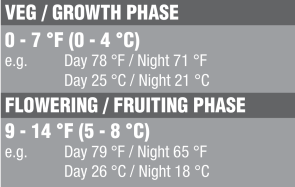
Introduction
Temperature, humidity and carbon dioxide (CO2) levels are key factors to monitor and control in any indoor garden. But don’t make the mistake of thinking about them separately! In order to really understand how your indoor garden environment works, you need to consider how these factors work together. The best way to do this is to take a look from a plant’s perspective…
Make the Link!
Growers use ventilation and cooling during the day and sometimes heaters during the night to manage their temperature differential. TDiffs larger than 18°F (10 °C) should be avoided as this can cause undue stress and impede growth.
How are Temperature and Relative Humidity Connected?
Humidity refers to the amount of water vapor in the air. But the higher the air temperature, the more water vapor air can hold. The term “relative humidity” links the two together (and also factors in air pressure) and is expressed as a simple percentage. A relative humidity of 100% means the air is carrying the maximum possible water vapor for a given temperature. 50% means it’s “half full,” etc.
So what do these percentages mean for your plants? Well, if humidity levels are too low (often caused by too much extraction, high light intensity and arid conditions outdoors) this can cause excessive water loss, desiccation (drying), poor growth and narrow, small leaves.
High relative humidity is usually caused by inadequate ventilation, often symptomatic of local climatic conditions (esp. on the east coast of the US) and results in little or no transpiration, fungal diseases, and very wide or large leaves.
Low relative humidity occurs when there is no available moisture for the air to carry. In warm, plastic lined, heavily ventilated grow rooms there is often no available moisture other than what is being drawn into the grow room, and the moisture transpired by the plants. Many warm grow rooms suffer with low relative humidity problems. Pests like red spider mite love hot, dry grow rooms!

Making the Link!
Too Hot, Too Cold, Just Right!
The temperature in your garden has a direct effect on the metabolic rate of your plants. In other words, if you let your garden get too cold (most common during the lights off period) your plants will only grow slowly and may become stunted. They will also become more prone to diseases. On the other hand, if conditions become too hot (often when grow lights have been on for several hours, and especially in poorly insulated buildings and / or hot climates, or insufficiently ventilated indoor gardens) then your plants will start to stretch and become leggy. The quality of your produce starts to deteriorate. If conditions are very hot your plants will shut down all together and go into survival mode
General Temperature Guide

Understanding Temperature Differential
The difference between the average “lights-on” and “lights-off” temperatures in your indoor garden is known as the temperature differential (TDiff). For example, if it is 78 °F (25 °C) in your garden when your grow lights are on and 68 °F (20 °C) when they are off, your TDiff is 10 °F (5 °C). A large TDiff can have negative effects on the growth of your plants and is most often caused by low night time temperatures and / or inadequate day time ventilation. A small TDiff can promote compact plant growth patterns. This is especially desirable during propagation and vegetative establishment.
When plants are flowering and fruiting a slightly larger TDiff is often more preferable indoors.
General Temperature Guide

What About CO2?
Carbon dioxide (CO2) is king! Before you worry about your nutrients’ NPK, remember this—carbon is the most important element your plants need! Plants absorb CO2 from the air via small pores in their leaves called stomata and use it as a building block to grow and bloom. But, for plants to use CO2 effectively, temperature and relative humidity have to be in range. Nutrients come second. CO2 is naturally present in the air at around 360-395 PPM. If you don’t keep CO2 levels topped up (either by ventilating with fresh air or supplementing with a CO2 cylinder or burner) your plants will run out of food. If this happens you can expect stretched, leggy growth, smaller fruits and airy, wispy flowers.

